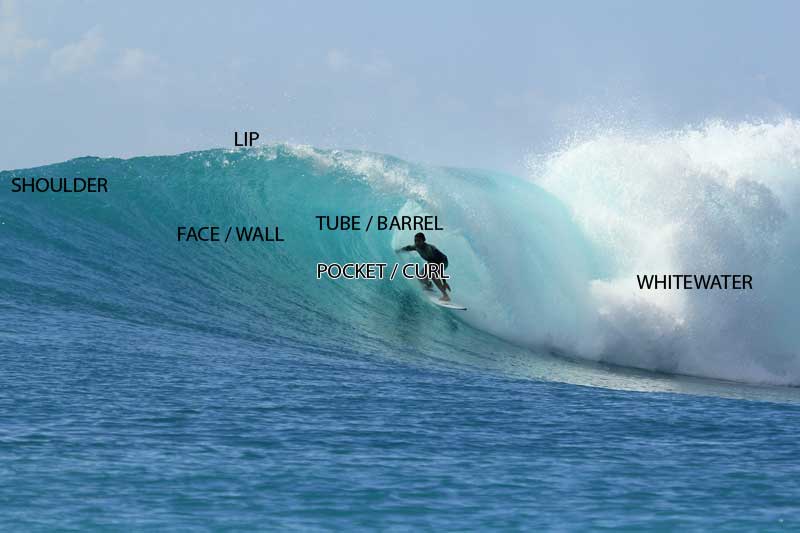Parts of a Wave and How to Read Waves
Reading waves and being able to estimate where and when a wave will break and how it will break, takes a lot of practice and time in the water. Your ability to predict what waves will do will grow as your surfing skills do.
People starting out in surfing find it difficult to see waves coming and where you should be to catch them, it's also one of the reasons why better surfers seem to be always in the right spot. Reading waves will also help you to determine when and where to do turns.
Below are some surfing terms and explanations to help you develop your wave reading skills.
Parts of a Wave
Lip: The lip is the top edge of the wave before it breaks.
Shoulder: Is the part that is further away from the breaking part, usually not so steep.
Face / Wall: The steep part of the wave out in front of where you surf.
Tube / Barrel: Is the part that is hollow that surfers aim for to get a tube ride or barrel ride.
Pocket / Curl: The part that is just before the wave breaks, it is where we get power to continue riding the wave.
Whitewater: Is the white foam of the wave after it has broken.
How to Read Surfing Conditions and Types of Waves
Right Hand Wave / Left Hand Wave
Whether a right or left hand wave, they are determined from the perspective of the surfer. Surfer goes right it is a right hand wave, from the beach the wave is actually going from right to left.

Choppy
Choppy refers to the overall conditions. On-shore winds (winds blowing from the sea to land) cause choppy conditions with white caps on the seas surface. When it's choppy the waves are not smooth and beautiful and we normally call the waves 'bumpy' in choppy conditions.
Crumbling Waves
When on-shore winds blow, we get what we call crumbling waves, where the wind causes the lip to crumble down the face of the wave. Crumbling waves can also happen on certain breaks where the bottom is a very gradual slope.
Glassy
Glassy is the opposite of choppy and is when there is little or no wind and the surface of the water is like glass.Smooth
Smooth is when the waves are smooth 🙂 Usually there is an off-shore wind blowing, which makes the waves straight and smooth. Off-shore winds also create 'spray', which is the wind blowing water off the lip and the spray goes backwards (out to sea).
Closeout Wave
A closeout wave is when the wave breaks all at the same time, leaving most surfers to go straight. That's why sometimes we call closeout waves straight handers. For better surfers a closeout can give the opportunity to do an air, a floater, or a closeout tube ride.
A-Frame Peak
A-frame waves allow the peak to be split by 2 surfers, one going left and one going right. If you are alone, you can choose to go either right or left.
Where You Are Surfing
There are 3 main types of surf breaks, that is, beach break, reef break and point break.
Beach Break
Beach breaks have a sand bottom and generally can be a bit more unpredictable, as the sand can move with conditions, so the peak you were surfing last week, may not be there today.Reef Break
Reef breaks have a reef or rock bottom, usually with a deeper channel on the side for paddling back out. Waves are more predictable as the reef doesn't move. Bali, Indonesia is famous for its reef breaks.
Point Break
Point breaks can either be rock or reef bottom, sand bottom or a combination of both. The waves break alongside a headland and can give very long rides. Places such as Lennox Head are well known point breaks.
Hopefully this will get you started on reading waves. If you feel we have left something out, or you have a question message us.
Next >>> Understanding The Tides
Other FAQsHow to spray paint your surfboard
Where can I find Learn to Surf Books & DVDs?

